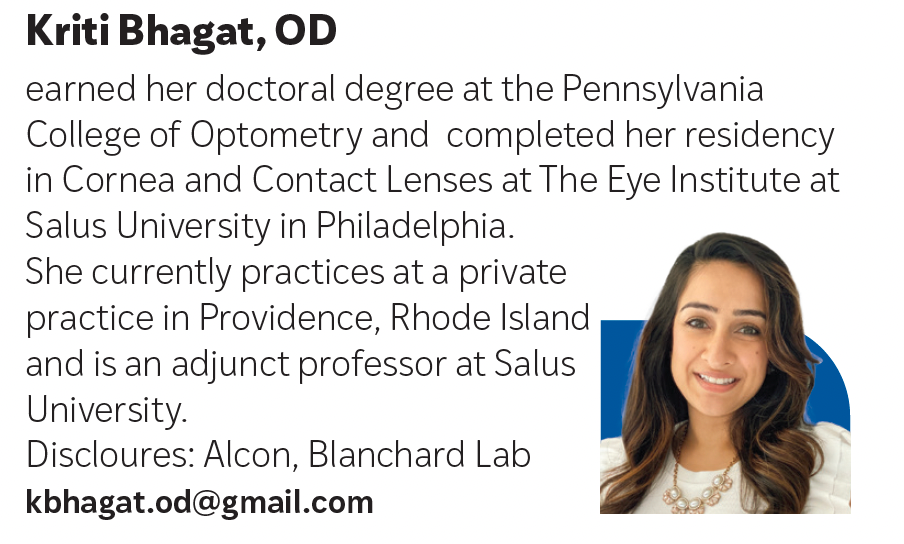- Therapeutic Cataract & Refractive
- Lens Technology
- Glasses
- Ptosis
- Comprehensive Eye Exams
- AMD
- COVID-19
- DME
- Ocular Surface Disease
- Optic Relief
- Geographic Atrophy
- Cornea
- Conjunctivitis
- LASIK
- Myopia
- Presbyopia
- Allergy
- Nutrition
- Pediatrics
- Retina
- Cataract
- Contact Lenses
- Lid and Lash
- Dry Eye
- Glaucoma
- Refractive Surgery
- Comanagement
- Blepharitis
- OCT
- Patient Care
- Diabetic Eye Disease
- Technology
The safety and efficacy of mass-produced colored contact lenses
Current findings review risks, benefits, and performance.


When the topic of colored contact lenses arises with a patient, the first thing that comes to mind is changing the eyes’ color.
Aside from cosmetic reasons, there are many ways colored or tinted contact lenses can help patients, such as decreasing glare or altering color perception for those who are color-blind.
Whether for cosmetic or therapeutic use, colored contact lenses are not generally something ODs mention to patients. However, once recommended, they are of interest to many patients.
Recommendations can be made from various standpoints. However they are delivered, it is important to note that although colored lenses can be advantageous to patients, they pose risks of which many are not aware. Let us review how colored contact lenses can safely, effectively benefit patients.
Related: Five ways to stand out with specialty contact lenses
Mass-produced colored contact lenses
Mass-produced colored contact lenses can be found in trial fitting kits and are easily accessible to dispense in an office setting.
Generally, these lenses are computer generated. Therefore, ODs cannot alter parameters like saturation, brightness, or alignment of the coloring.
Mass-produced colored contact lenses can either enhance the natural color of patients’ eyes or change it completely. They fit similarly to most soft contact lenses used for correcting refractive errors.
Therefore, additional chair time is not needed when compared to mass-produced clear, soft contact lenses.
Most mass-produced colored lenses are available in spherical powers with daily or monthly replacement schedules. The lenses’ lower cost, resulting from mass-production, allows them to be easily introduced to patients as a full-time or temporary wear option.
Mass-produced colored contact lenses are generally popular for wearing to social events.1 Because of their clear backing and colored pigments surrounding the iris, they allow for a variation of patterns that can create either a natural or bold appearance.
Related: Contact lens overwear leads to short-term, long-term consequences
For example, patients with brown eyes can choose brown or hazel hues to slightly alter the color of the iris or may choose blue or green hues to alter the appearance more dramatically.
Despite the ease of fitting and of educating patients about options, these lenses have the highest rates of complications among contact lens wearers.2
Complications
Although the risks of cosmetic lenses are obvious to the ODs who have seen the ocular consequences, the general population is often unfamiliar with the threats they pose to eye health.
When Berenson et al surveyed patients on their knowledge and use of cosmetic contact lenses, results showed many patients were unaware of the risks and proper instructions for utilization.3,4
According to the survey, 1 in 4 patients reported prior use of cosmetic lenses and many had obtained the lenses from unauthorized sources.
When questioned about contact lens knowledge, results revealed many patients were not aware of proper wear protocol.3
A majority of patients did not know that selling contact lenses over the counter and without a prescription is illegal nation-wide. They were also unaware that contact lenses are not 1 size fits all, that parasites can attach to lenses, and that “anime” lenses are not FDA approved.3
Related: Poll Results: What is your biggest frustration with contact lens fitting?
Of the patients surveyed, 62.3% said they were never taught how to clean their contact lenses.3
Although we may be aware of some of these findings, it is important to examine how cosmetic lenses raise the chances of adverse events (AEs) compared with clear contact lenses.
AEs
Colored contact lenses pose a higher risk of infection and inflammatory events due to their composition. A recent study examined various cosmetic contact lenses to identify where the pigment was in the layers of the lens.5
It found that most lenses analyzed contained the bulk of the pigment within 0.4 mm of the surface. The extent of pigment enclosure is not regulated in most countries, but the location affects safety and comfort.5
Another study found that most contact lens brands failed the rub-off test, leading to detachment of the color pigments.6
The rub-off test uses cotton swabs to gently rub the front and back surface of the contact lens for 20 second and then measures the amount of color pigment detachment.
Related: Use OCT to determine scleral lens clearance
Lenses that failed the rub-off test showed a higher Pseudomonas aeruginosa adherence, which led to an increase in AEs and more sight-threatening AEs. These pigments are found to have elements toxic to the ocular surface tissue.7
The presence of any pigment can lead to AEs. Lau et al found that lenses with pigments on the surface of the lens (front or back) had significantly higher friction values in pigmented areas vs clear regions.8
The study concluded that cosmetic lenses with exposed pigment have less consistent surfaces, leading to decreased lubricity and increased surface roughness.
Lubricity and roughness play an integral part in keeping a stable tear film. Therefore, disruption leads to unstable visual acuity and a decrease in contact lens comfort.
Acanthamoeba keratitis can occur with all types of contact lenses and it is a risk that we discuss with all new wearers. Teaching patients about avoiding the use of water with soft contact lenses is a key element in insertion and removal training when dispensing a lens.
Multipurpose and hydrogen peroxide solutions have helped decrease microbial-related AEs, but recent studies have found that the composition of the lenses can affect the likelihood of Acanthamoeba attaching to the lens.9
Related: Give toric ortho-k lenses a try
Scanning electron microscopy imaging
With the use of scanning electron microscopy images, Lee et al found that the noncolored surface of cosmetic contact lenses was smoother and flatter than the colored areas.
They also found a greater number of Acanthamoeba trophozoites attached to the colored, rough area vs the noncolored, smoother area.
As the demand for cosmetic contact lenses increases this is a risk that should be discussed with patients wearing colored lenses.
With newer lens materials, such as silicone hydrogel, most mass-produced contact lenses provide more than necessary oxygen permeability.
Oxygen transport is measured through the central optical zone of the lens, leaving the oxygen transmission questionable in the periphery.
A study by Galas and Copper used special lenses, specifically created with pigment through the central optical zone, to measure the oxygen permeability through the pigment.10
They found that the pigment did not statistically influence the oxygen permeability, therefore demonstrating that it does not decrease or alter lens safety.
Related: Experts offer tips for success in contact lens practice
Conclusion
Despite the disadvantages of mass-produced contact lenses, there has been a steady increase in their use. This article aims to help practitioners understand why education is such a vital part of dispensing colored contact lenses.
Whether the use is cosmetic or therapeutic, patient education and awareness of risks can help decrease AEs and increase colored contact lenses’ safety.
Read more contact lens content
--
References
1. Rah MJ, Schafer J, Zhang L, Chan O, Roy L, Barr JT. A meta-analysis of studies on cosmetically tinted soft contact lenses. Clin Ophthalmol. 2013;7:2037-2042. doi:10.2147/OPTH.S51600
2. Ji YW, Cho YJ, Lee CH, et al. Comparison of surface roughness and bacterial adhesion between cosmetic contact lenses and conventional contact lenses. Eye Contact Lens. 2015;41(1):25-33. doi:10.1097/ICL.0000000000000054
3. Berenson AB, Hirth JM, Chang M, Merkley KH. Knowledge and use of cosmetic contact lenses among reproductive-age women. J Womens Health (Larchmt). 2019;28(3):403-409. doi:10.1089/jwh.2018.7358
4. Berenson AB, Chang M, Hirth JM, Merkley KH. Use and misuse of cosmetic contact lenses among US adolescents in Southeast Texas. Adolesc Health Med Ther. 2019;10:1-6. doi:10.2147/AHMT.S196573
5. Korde V, McDow K, Rollins D, Stinchcomb R, Esposito H. Identifying pigment enclosure in cosmetic contact lenses. Eye Contact Lens. 2020;46(4):228-233. doi:10.1097/ICL.0000000000000632
6. Chan KY, Cho P, Boost M. Microbial adherence to cosmetic contact lenses. Cont Lens Anterior Eye. 2014;37(4):267-272. doi:10.1016/j.clae.2013.12.002
7. Hotta F, Eguchi H, Imai S, Miyamoto T, Mitamura-Aizawa S, Mitamura Y. Scanning electron microscopy findings with energy-dispersive x-ray investigations of cosmetically tinted contact lenses. Eye Contact Lens. 2015;41(5):291-296. doi:10.1097/ICL.0000000000000122
8. Lau C, Tosatti S, Mundorf M, Ebare K, Osborn Lorenz K. Comparison of the lubricity and surface roughness of 5 cosmetic contact lenses. Eye Contact Lens. 2018;44 Suppl 2(2):S256-S265. doi:10.1097/ICL.0000000000000482
9. Lee SM, Lee JE, Lee DI, Yu HS. Adhesion of Acanthamoeba on cosmetic contact lenses. J Korean Med Sci. 2018;33(4):e26. doi:10.3346/jkms.2018.33.e26
10. Galas S, Copper LL. Oxygen permeability of the pigmented material used in cosmetic daily disposable contact lenses. Clin Ophthalmol. 2016;10:2469-2474. doi:10.2147/OPTH.S105222

